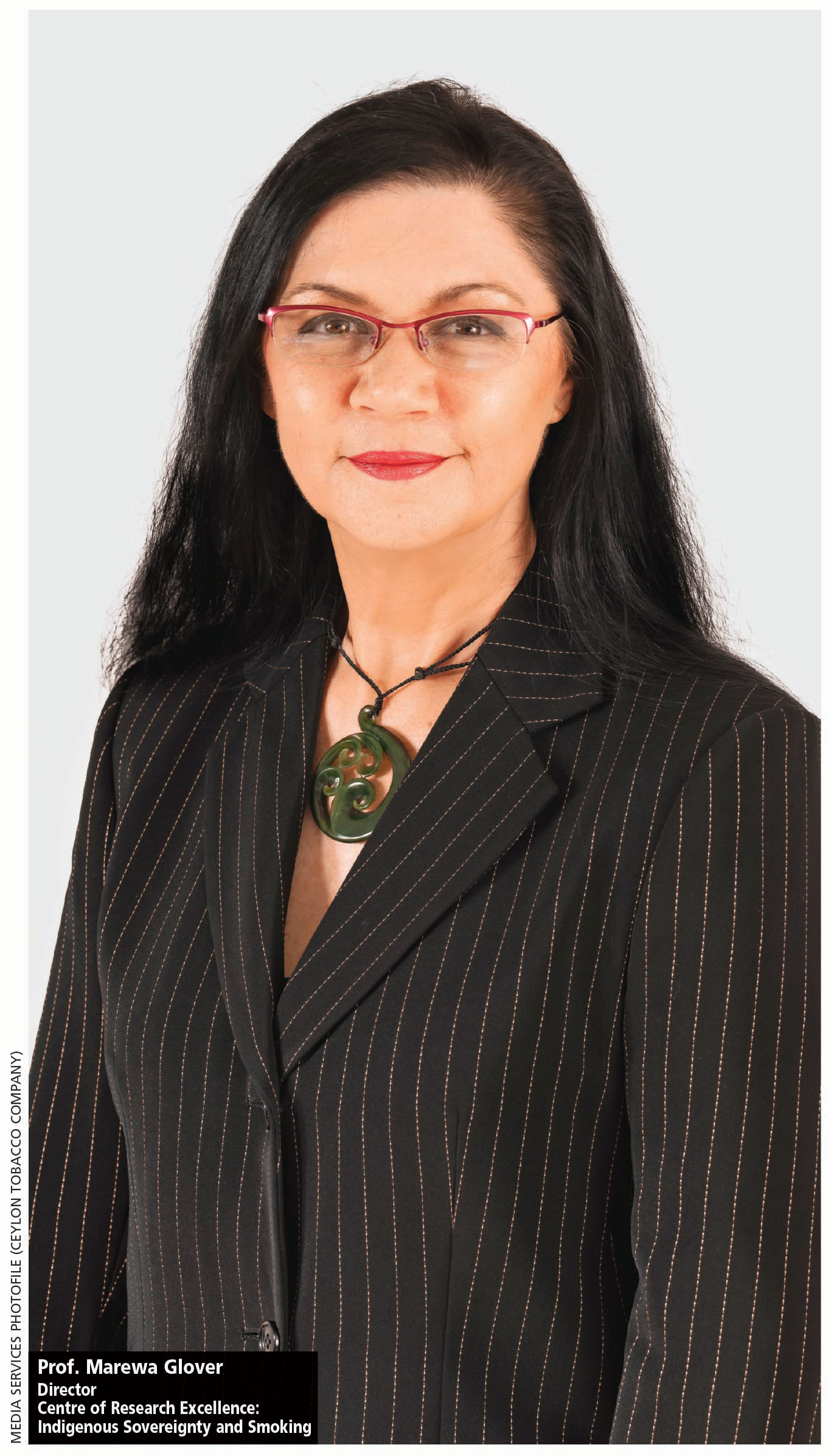PROF. MAREWA GLOVER
HOW NEW ZEALAND BECAME A BLUEPRINT FOR TOBACCO CONTROL
Prof. Marewa Glover is a leading New Zealand public health researcher and internationally recognised expert in tobacco harm reduction (THR). With over three decades of experience in smoking cessation and health equity, she has played a pivotal role in shaping New Zealand’s progressive approach to reducing the use of tobacco.
Her work has been instrumental in highlighting how innovation and regulation can drive public health transformation. In this interview on smoke-free New Zealand, Glover outlines how her country’s THR model centred on vaping, oral nicotine pouches and accessible alternatives have helped halve smoking rates in only seven years, offering valuable insights for nations such as Sri Lanka.
Q: How has New Zealand successfully reduced smoking rates and what lessons can Sri Lanka learn from its approach?
A: Between 1990 and 2013, New Zealand’s smoking rates declined only marginally despite strong control measures such as advertising bans, smoke-free environments and high taxes. The real breakthrough came after 2015 when large numbers of smokers switched to vaping and oral nicotine pouches.
In 2020, the government legalised and actively promoted vaping for adults who were unable to switch from smoking conventional cigarettes through pharmaceutical therapies. Over the next seven years, daily smoking prevalence halved from 14.1 percent in 2016/17 to 6.9 percent in 2022/23.
The key lesson for Sri Lanka and other countries is that lasting change comes not from restriction but providing adults with access to potentially reduced risk nicotine alternatives that are as accessible and affordable as cigarettes.
In New Zealand, a risk proportionate tax system ensures these reduced risk products cost less than conventional cigarettes. This encouraged smokers to make the switch. Harm reduction, not prohibition, has proven to be a more effective and more humane way forward.
Q: How can Sri Lanka develop policies that encourage adult smokers to switch to potentially less harmful alternatives such as e-cigarettes?
A: New Zealand combines strong tobacco control with practical harm reduction. Crucially, the government legalised vaping, removed excise taxes on vaping products and launched national campaigns such as ‘vape to quit strong,’ which reframed vaping as a practical step towards quitting smoking. It offers free quitting support through quit line services, cessation clinics and nicotine replacement therapies.
This integrated policy mix combining regulation, taxation, education and accessibility has successfully encouraged smokers to move away from conventional cigarettes. For Sri Lanka, introducing a similar framework could help bridge the gap between policy intention and public health outcomes.
Q: How can Sri Lanka ensure that alternative nicotine products are accessible while preventing misuse – especially among youth under the age of 21?
A: In New Zealand, all potentially reduced risk nicotine products can only be sold to adults aged 18 and above. The country also provides educational materials to ensure compliance and strict penalties are imposed for selling to minors.
Regular inspections are conducted by enforcement officers to ensure compliance and there are heavy fines for any violations involving underage sales. Packaging restrictions prohibit cartoon imagery or flavours designed to appeal to minors.
These clear, enforceable rules and safeguards in New Zealand have helped prevent youth access while allowing adults to benefit from harm reduction options. These are simple approaches that Sri Lanka can and should take into consideration.
Q: What impact would a shift to reduced risk nicotine products have on Sri Lanka’s healthcare system and smoking related diseases?
A: Evidence from Sweden shows that moving smokers to safer alternative products dramatically lowers rates of smoking related diseases, freeing up healthcare resources for other priorities. Similarly, Japan and New Zealand have also seen rapid declines in smoking related hospitalisations following the adoption of harm reduction strategies.
In New Zealand, this shift has been most pronounced among lower income groups where smoking was historically highest, helping to narrow health inequities while easing long-term public health costs. And for Sri Lanka, adopting a similar model could mean a reduction in smoking related illnesses; lower treatment costs; and healthier, productive communities going forward.
Q: How can public health campaigns in Sri Lanka educate adult smokers about the benefits of switching to potentially reduced risk alternatives?
A: New Zealand’s government runs sustained public education through mass media and dedicated online platforms such as vapingfacts.health.nz which provide science based information about vaping. Access to credible information such as this effectively counters misinformation and empowers adult smokers to make informed decisions about reduced risk nicotine alternatives.
Mass media and social media campaigns that highlight real stories of people who have quit smoking through safer alternatives could, in fact, create a positive cultural shift. Sri Lanka could adopt similar campaigns that focus on education instead of fear as this could help reshape public perceptions and guide smokers toward healthier, more informed decisions.
Q: How can Sri Lanka measure the success of THR policies, similar to New Zealand’s progress in cutting smoking rates?
A: New Zealand tracks smoking and vaping trends through its annual Health and Lifestyles Survey (HLS), which consistently shows that as vaping rates rise, smoking rates fall. Similar data collection and monitoring could help Sri Lanka evaluate policy impact, identify emerging trends and align with global evidence from the UK, the US, Japan and Iceland – all countries that have achieved steep declines in smoking through harm reduction.
The country’s journey towards a smoke-free future demonstrates that evidence based THR policies can achieve what decades of prohibition and taxation alone could not. By legalising and regulating reduced risk nicotine alternatives, the country empowered smokers to make lifesaving choices while narrowing health inequities across its population.
For Sri Lanka, implementing a national health behaviour survey would enable policymakers to measure real world outcomes, evaluate policy effectiveness and adapt strategies based on evidence. By learning from the experiences of countries such as the UK, the US and Japan, Sri Lanka can chart a realistic path toward reducing tobacco harm and achieving its own smoke-free future.
As Glover emphasises, the path to a smoke-free society lies not in punishment but providing accessible, affordable and effective alternatives. For Sri Lanka, adopting this pragmatic approach could pave the way towards a healthier and more equitable future guided by innovation instead of restriction.







